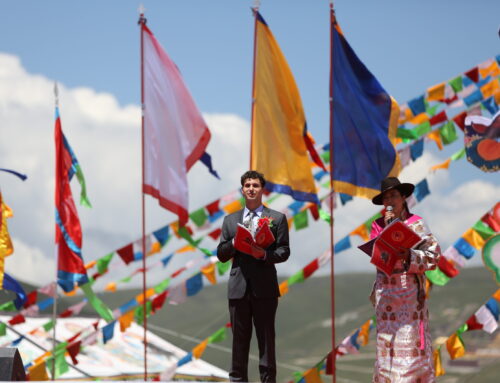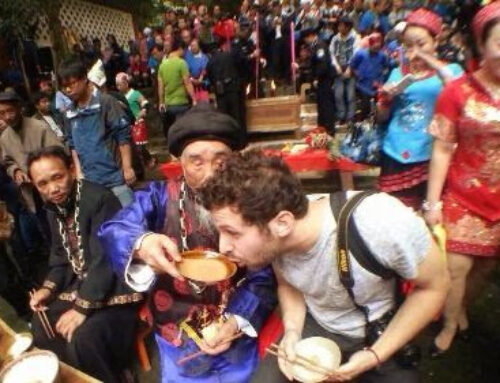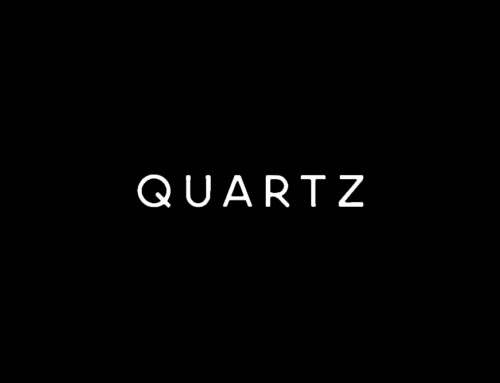LESSONS FROM THE NEAR FUTURE
Rebuilding Social Trust and the Gym Conundrum
After months of being told that contact with others could be potentially lethal, how do we mend the torn fabric of social trust? Or, asked a different way: How do we reopen institutions that require us to trust the people we are near? Simpler still: How do we feel safe sweating among strangers again?
The story of covid-19 transmission is a story of droplets.
The World Health Organization writes that the disease is spread “between people through respiratory droplets and contact routes.”
Breathing hard and flying droplets causes disease? First thought: gyms are in deep shi*t.
The good news is, based on what we’re seeing in China, maybe not…
We’re using gyms here to represent an extreme case of social trust in shared spaces. Many of these lessons hold true for restaurants, stores, cafes, subways, and so on.
This last week we spoke to dozens of gym owners and gym goers – including some in Wuhan – who are back in business and burning off quarantine bellies.
For gym owners, and the same for all shared-space proprietors, the challenge is very clear:
After months of being told “don’t trust thy neighbors”, the task of gyms, restaurants, hotels, and other shared spaces is to convince customers, “you can at least trust these ones.”
Before we begin on how they did it, it’s worth noting that gyms were among the last businesses to open. Office buildings opened first. Then stores and restaurants. Gyms came last. They’re also the first thing to shut down when virus cases resurfaces.
Also, many gyms didn’t survive quarantine. QiChaCha noted that more gyms in China went out of business in the first three months of the year than in all of 2015.
A bright spot: Refocusing on health. While there is a feeling that healthy people can fall prey to the virus, there is general consensus that the virus disproportionately picks on the vulnerable with underlying conditions.
The health industry and health awareness is on the rise in China. Live streamed fitness classes boomed and Chinese app Keep topped app store charts during Covid. Before covid-19 the fitness industry was growing rapidly. Now more than ever the need for “good health” and preventative health is clear.
The Safety Caveat: It only takes one person to undermine a shared space.
The reintroduction of the semi-shared commons—restaurants, clothing stores, subways, gyms, and more—relies on your ability to trust your neighbor.
That means trusting everyone in the room – no exceptions. As one gym owner in Ningbo, a 2nd tier city in Zhejiang province reminded me over a phone interview on Monday:
一粒老鼠屎,坏了一锅粥
Yī lì lǎoshǔ shǐ huàile yī guō zhōu
It only takes one small piece of rat poop to ruin an entire pot of porridge
What does that mean exactly? A CrossFit owner in Beijing told me via WeChat, “You have to feel that everyone is safe in the gym, or no one will feel safe.”
Chinese gyms—and other businesses—have done their best to create the impression of hermetically sealing their spaces against infection, and, most importantly, the infected.
Here’s how they’ve done it. One key difference we noticed with Chinese businesses and American businesses: they didn’t have to insist on these protocols; they were required by government. Individual businesses may have to self-impose these protocols in other countries.
#1 Their most important step is a contact tracing app we won’t use
The most instrumental tool in fast-patching social trust has been a technology that we in America will never use. It’s called Health Code, and was made by Ant Financial (of Alibaba) in collaboration with the Chinese Government.
“Health Code” is a phone app that, based on your medical records, who you’ve been in contact with, and where you’ve traveled, gives you a health code of Green, Yellow, or Red. For the months directly after lockdown, everyone throughout China presented this code to gain access to any public place. (Video here of the Beijing subway from NYT.)
What happens if you got a “red”? You were told to self-quarantine at home for 14 days.
After quarantine, nearly all malls and office buildings require you show your Health Code to gain entry to a building.
My friend and co-owner of Sinostage, Eli, China’s best-known hip-hop dance studio that runs on a class model, told me their 7 Chengdu studios still require it at the door.
“The Health Code app allows everyone in the space to know, ‘Hey, you’re surrounded by people who have been responsible and are healthy.’”
Sinostage runs dance gyms across the country: seven in Chengdu, and new locations in Beijing and Shanghai. They were fully shut down during quarantine and now have surged back to 80% capacity. Most gyms we spoke with were operating between 60%-80% capacity.
Here’s what happens at Sinostage:
- Class-goers get temperature checked at the entrance of the mall.
- Customers show their Health Code with a “Green” for “healthy” rating at the front desk, which cross-references their medical records, travel records, and who they’ve been in contact with.
- Class numbers are controlled to avoid over crowding. They’re booked in advance.
- Masks are not mandatory in classes, but staff wear them. People dance, sweat, film themselves, go home. (Other gyms we spoke with in higher risk areas, masks are mandatory.)
- The spaces are rigorously disinfected before the next class.
Sinostage celebrity teacher Apple Yang posted this video early this AM from a class in Chengdu. Very few masks, happy dancers. This “normalcy” is only possible through the mutual assurance of the Health Code app and temperature testing.
Eli Sweet, co-founder of Sinostage alongside co-founder, CEO, and wife Koko Ren, reminded me that, “This also feels less invasive when you’re used to scanning your face to register for a class and scanning a QR code to pay for the class.”
They give up data freedoms for that peace of mind, freedoms that are not protected in China to begin with.
But it’s not just more authoritarian governments like China and Singapore using this tech.
Democracies like South Korea also lean heavily on contact tracing, “testing, monitoring, and tracking patients and disclosing critical information to the public.” As of May 5th, the UK is using contact tracing apps too.
We should be doing some version of this in the US, but we likely will not, unless it is “opt-in,” such as Microsoft’s.
“Opt-in” doesn’t cut it if people are meant to feel and actually be secure.
We aren’t just talking cosmetics. Health Code keeps people with the virus or exposed to it out of the public sphere, which will remain essential as we open up our businesses over the next month.
#2 Temperature checks, a MUST for social trust
They are checking temperatures at the door. People with abnormal temperatures are denied access.
Without an app, this is the best retailers can do, and we believe that every gym and restaurant in the US should do it.
If you’re a business owner, please take temperatures! Not only are you protecting your employees and customers, it could be good for business as you give people peace of mind.
After a few weeks of interviews with gym users, shop goers, restaurant eaters, and hotel stayers, aside from the Health Code App, this is the absolute essential that gives people peace of mind.
Fever is the surest sign you maybe have Corona, but certainly that you’re not healthy. The Economist summarizes the knowledge that’s being put to work all over Asia that “Taking people’s temperature can help fight Corona.”
#3 Mandatory masks, which eases over time
For the last several decades, we’ve misunderstood why people in Asia wear masks. We assumed it was paranoia about contact with the outside world. In reality, most in Asia have worn masks when they’re sick. The idea is not to spread.
We’ve just woken up to this concept and it’s a good one. Most masks don’t keep us from getting sick but they do keep our droplets to ourselves. Again, this only works if everyone is buying in.
#4 Use apps to limit overcrowding
Gyms limit overcrowding by reserving time slots beforehand via apps.
A gym owner in Wuhan who is back in business –you read that right— has told me that, aside from Health Code and temperature checks, all customers book their workout time slots in advance, with an occupancy limit.
Larger gyms are even having people book their specific equipment so that staff can be alerted to disinfect after use.
#5 Disinfect early, often, and visibly
There is no replacement for high-grade, high impact, and high visibility cleaning. Alongside the DIY wipes typically in gyms, many are hiring extra staff.
Most people we’ve interviewed in China cannot conceive of society restarting without these technological health assurances.
On my call with a member of Young China Group in Wuhan, I told her how I was in line at USPS today to return a sweatshirt my mom ordered me.
“They don’t take your temperature before you get in line at the Post Office?” she asked. I told her no.
“So, you’re in line with total strangers…and you don’t know if the people in front of you, behind you, all around you have any fever symptoms?”
I told her I do not know if they have fever symptoms. She, who had just left 76 days of quarantine, paused for a full beat.
“So you’re risking your life to return a shirt? Go home.”
Last note we covered Fear and Desire. The Atlantic quoted from the piece and included other worth-your-attention commentary. You might also like this piece on “How Wuhan Residents Wished They Spent Their Quarantine” I wrote for Quartz.






Leave A Comment